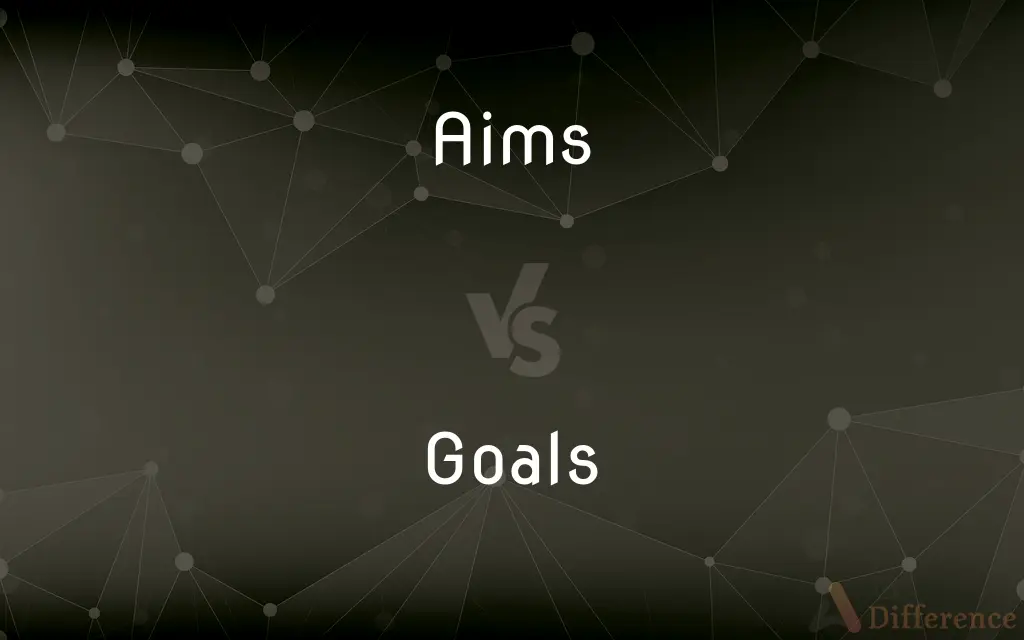Aims vs. Goals — What's the Difference?
By Urooj Arif & Maham Liaqat — Published on October 28, 2024
Aims are broad, general statements of desired outcomes, reflecting the long-term vision, while goals are specific, measurable objectives that detail how to achieve these aims.

Difference Between Aims and Goals
Table of Contents
ADVERTISEMENT
Key Differences
Aims represent the overarching aspirations or the ultimate results that an organization, individual, or project seeks to achieve. They are broad and long-term, often lacking in specificity and measurability. Aims provide the guiding direction or the 'why' behind efforts and initiatives, setting the stage for more detailed planning. For example, an aim could be to improve public health in a community.
Goals, in contrast, are concrete targets set to accomplish the aims. They are specific, measurable, achievable, relevant, and time-bound (SMART), making it easier to track progress and success. Goals break down the aim into manageable parts, offering clear milestones that need to be achieved. For instance, a goal to support the aim of improving public health could be to reduce the incidence of a particular disease by 25% within five years.
Aims give a broad sense of purpose or direction, while goals provide the steps needed to get there. This distinction is crucial in planning and strategy development, as it helps in organizing efforts and resources efficiently. By setting both aims and goals, an entity can maintain a clear focus on its long-term vision while also taking concrete steps towards achieving it.
The relationship between aims and goals is hierarchical. Aims set the broad vision, and goals act as the stepping stones towards realizing that vision. This structure ensures that all efforts are aligned with the overarching aspirations, facilitating a coordinated approach to achievement and success.
Comparison Chart
Definition
Broad statements of desired outcomes
Specific objectives that are measurable
ADVERTISEMENT
Scope
General and long-term
Detailed and short to medium-term
Measurability
Not usually measurable
Measurable with specific criteria
Purpose
To provide direction and motivation
To offer clear, actionable steps towards the aim
Example
Improving public health
Reducing the incidence of a particular disease by 25% in five years
Compare with Definitions
Aims
General intentions or desired outcomes.
The aim of the organization is to foster a world where every child has access to education.
Goals
Specific, measurable steps towards an aim.
The goal is to increase literacy rates by 10% in the next five years.
Aims
Reflect the big picture or vision.
Their aim is to combat climate change through innovative solutions.
Goals
Include clear targets and deadlines.
Their goal is to plant one million trees by the end of the decade.
Aims
Serve as the ultimate purpose.
The aim of the policy is to promote equal opportunities for all citizens.
Goals
Help in tracking progress.
The goal for this quarter is to improve customer satisfaction scores by 15%.
Aims
Provide the foundational direction.
The aim of the study is to understand the impact of social media on mental health.
Goals
Are actionable and quantifiable.
The project goal is to reduce waste production by 20% within three years.
Aims
Are broad and long-term.
The company’s aim is to be the leader in renewable energy by 2030.
Goals
Align with broader aims for focused efforts.
The team's goal is to develop three new sustainability projects this year to support the aim of environmental conservation.
Aims
To direct toward or intend for a particular goal or group
The publicity campaign was aimed at improving the eating habits of children.
Goals
The object toward which an endeavor is directed; an end.
Aims
To propose to do something; intend
The historical society is aiming to restore the town hall.
Goals
A structure or area into which players endeavor to propel a ball or puck in order to score points.
Aims
The act of aiming
Take careful aim.
Goals
A play or shot that sends a ball or puck into or through the goal.
Aims
The degree of accuracy of a weapon or of a person aiming a weapon or propelled object
Your aim was way off on that throw.
Goals
A noun or noun phrase referring to the place to which something moves.
Aims
A purpose or intention toward which one's efforts are directed
My aim was to try to make him laugh.
Goals
Extremely admirable; worthy of being set as a goal and emulated.
Your relationship is goals AF!
Aims
Plural of aim
Goals
Plural of goal
Common Curiosities
What is the main difference between aims and goals?
Aims are broad, long-term aspirations, while goals are specific, measurable steps to achieve these aims.
How many goals can support an aim?
Multiple goals can and often do support a single aim, addressing different aspects or milestones needed to achieve the overall aim.
Can goals change over time?
Yes, goals can be adjusted based on progress, feedback, or changes in circumstances, while still aligning with the original aims.
How do aims and goals relate to objectives?
Objectives are often similar to goals, being specific and measurable, but can sometimes be used interchangeably with aims in less formal contexts.
Can personal endeavors have aims and goals?
Yes, individuals can set aims and goals for personal development, education, career, or other personal projects.
Can aims be achieved without setting goals?
While aims provide direction, achieving them typically requires setting specific goals to outline the steps needed.
Why are goals important in achieving aims?
Goals offer clear, actionable steps, making it easier to track progress and ensure efforts are aligned with the overarching aims.
How should goals be formulated to effectively achieve aims?
Goals should be SMART (Specific, Measurable, Achievable, Relevant, Time-bound) to effectively guide actions towards achieving aims.
Can the failure to meet a goal affect the overall aim?
While failing to meet a goal can be a setback, it provides an opportunity to reassess and adjust strategies or set new goals to still achieve the aim.
Is it necessary to have both aims and goals?
Having both helps clarify the long-term vision (aim) and the specific steps (goals) needed, enhancing focus and efficiency.
Share Your Discovery

Previous Comparison
Chop Suey vs. Chow Mein
Next Comparison
Royal Blue vs. Cobalt BlueAuthor Spotlight
Written by
Urooj ArifUrooj is a skilled content writer at Ask Difference, known for her exceptional ability to simplify complex topics into engaging and informative content. With a passion for research and a flair for clear, concise writing, she consistently delivers articles that resonate with our diverse audience.
Co-written by
Maham Liaqat









































